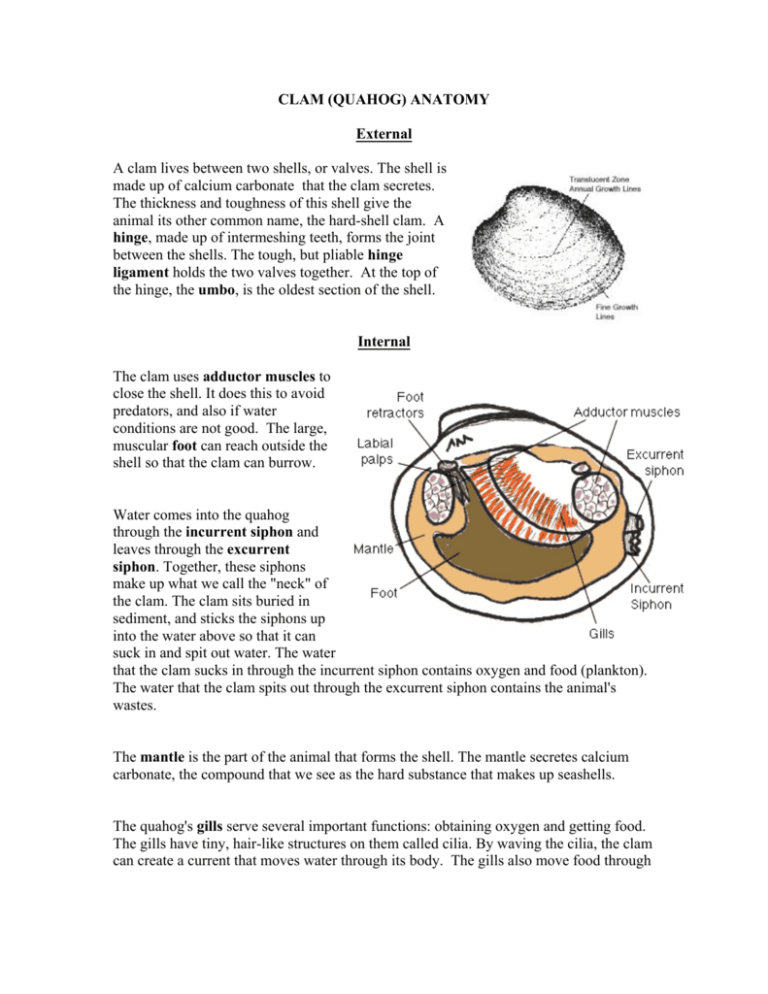CLAM (QUAHOG) ANATOMY
advertisement

CLAM (QUAHOG) ANATOMY External A clam lives between two shells, or valves. The shell is made up of calcium carbonate that the clam secretes. The thickness and toughness of this shell give the animal its other common name, the hard-shell clam. A hinge, made up of intermeshing teeth, forms the joint between the shells. The tough, but pliable hinge ligament holds the two valves together. At the top of the hinge, the umbo, is the oldest section of the shell. Internal The clam uses adductor muscles to close the shell. It does this to avoid predators, and also if water conditions are not good. The large, muscular foot can reach outside the shell so that the clam can burrow. Water comes into the quahog through the incurrent siphon and leaves through the excurrent siphon. Together, these siphons make up what we call the "neck" of the clam. The clam sits buried in sediment, and sticks the siphons up into the water above so that it can suck in and spit out water. The water that the clam sucks in through the incurrent siphon contains oxygen and food (plankton). The water that the clam spits out through the excurrent siphon contains the animal's wastes. The mantle is the part of the animal that forms the shell. The mantle secretes calcium carbonate, the compound that we see as the hard substance that makes up seashells. The quahog's gills serve several important functions: obtaining oxygen and getting food. The gills have tiny, hair-like structures on them called cilia. By waving the cilia, the clam can create a current that moves water through its body. The gills also move food through the body. When water comes in through the incurrent siphon, particles of silt and food are trapped on the layer of mucous on the outer surface of the gills. From there, the cilia move the particles along food grooves toward the labial palps, where they are sorted. Food particles move on toward the mouth. Other particles—such as silt or excess phytoplankton—are dropped onto the surface of the mantle, where the clam eventually gets rid of them in mucous-coated balls. Food particles move from the mouth and esophagus to a multi-chambered stomach with numerous passageways and dead-end sacs. Located inside the muscular foot are the intestines, digestive glands, and gonads. The quahog has an "open" circulatory system, so that once the hemolymph gets to the outer tissues, it leaves the blood vessels and flows into open sinuses, or cavities, where it directly bathes the tissues. In contrast, in our circulatory systems, blood always stays in some kind of blood vessel, such as capillaries. CLAM DISSECTION 1. Identify the following external structures: umbo, shell, hinge 2. To open the clam, you have to cut through the 2 adductor muscles with the scalpel. Insert your scalpel before the hinge on one side and move it towards the hinge until you feel resistance. Then using a slicing motion, keep pushing the scalpel forward until you are through the muscle. Do the same on the other side 3. Once the adductor muscles are cut, slowly and carefully pry open the shells so you can see the internal structures 4. Once the shells are pulled open so they are horizontal, identify the following internal structures: gills, foot, mantle, labial palps 5. To open the foot, run the scalpel the long way through the foot so you can see inside. Identify the following structures: digestive glands (greenish mass), intestine, gonads (yellowish mass) Reference http://seagrant.gso.uri.edu/G_Bay/HabitatEco/Shellfishing/quahog_dissect.html











